Starting with Draw
TDF LibreOffice Document Liberation Project Community Blogs Weblate Nextcloud Redmine Ask LibreOffice Donate
Foreword
This video shows how to get started with Draw in LibreOffice and links to this page here for more information and details.
This description here should make it easier for you to get started with Draw.
If you are migrating from another Office suite to LibreOffice, you can find some basic information here: https://wiki.documentfoundation.org/Videos/Transition_from_MS-Office_to_LibreOffice
Link to the Video
Link to the Video (in German [DE]):
Starten mit Draw - LibreOffice This video is in work!
Introduction
All questions about Draw can be found in the Draw manual with the individual chapters.
The term "Drawing" is also used for the Draw component.
Settings in Draw
Depending on what you want to draw, it may be useful to make default settings.
You can find all the important default settings in the ▸ menu.
The "Options - [SELECT]" dialog opens.
If you are not sure about the settings, leave them as they are for the time being.
They are set to default values.
You can still start drawing.
Start with the settings for the grid and the drawing scale, if necessary.
Setting the drawing scale

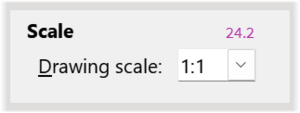
Depending on what you want to draw, it may be useful to preset the Drawing scale for the desired use before starting.
You can specify the Drawing scale in the menu via ▸ ▸ ▸ at Scale.
Or you select the Drawing scale in the Statusbar at Scale with a rightclick.
Switch on Grid and Helplines
Go to the menu ▸ ▸ ▸ to adjust the spacing (Resolution) of the grid points.
These settings help you to quickly find the start and end points when drawing.
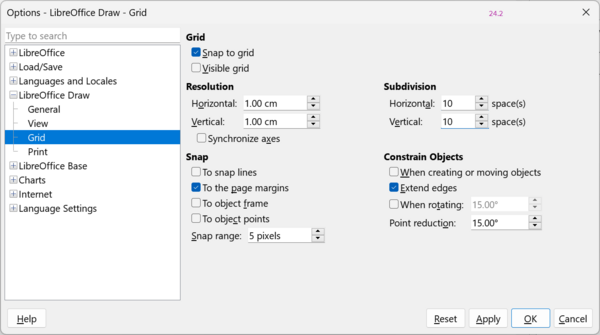
You can select one of the submenus via the ▸ menu:
Use the "Standard" toolbar to select one of the icons as required:
- "Display Grid"
- "Snap to Grid"
- "Helplines While Moving"
Switch on Snap lines and Rulers
Snap lines can be positioned independently of the grid.
The rulers must be visible for this.
You can display the rulers via the ▸ menu.
Click-hold-drag from a ruler to the workspace and release the mouse button at the desired position to set a snap line.
You can drag any number of snap lines to the workspace.
Right-click on a snap line to open a context menu with two selection options:
If you select you get the dialog "Edit Snap line".
In this dialog, you can specify the X value in cm for a vertical snap line and the Y value for a horizontal snap line.
You have four buttons to choose from in this dialog.
You can select one of the submenus via the ▸ menu:
Layers in Draw
Draw uses drawing layers.
These allow you to group similar objects together in one layer.
You can also create your own layers for your objects, see:
How do you start creating a drawing?
Start LibreOffice on your PC or notebook.
In the Start Center, select "Draw Drawing"
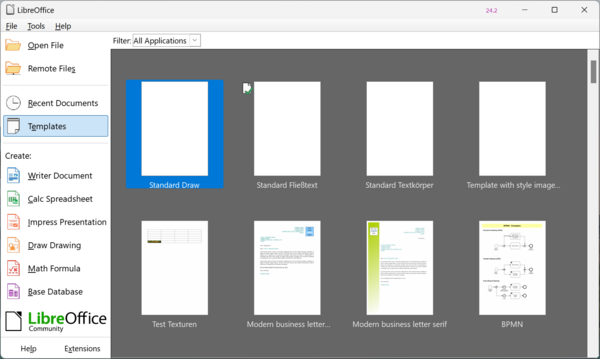
Note: You can also start Draw from any other component.
To do this, select ▸ ▸ from the menu.
First select a layer below the work area in which you want to start drawing.
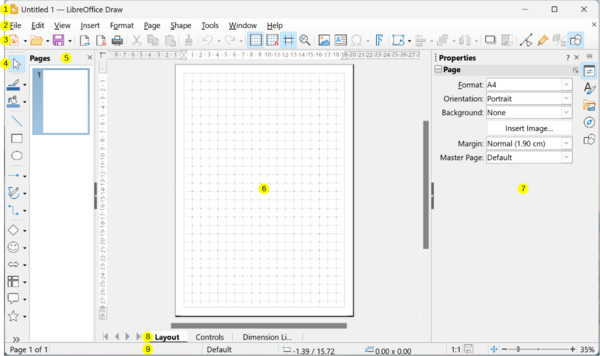
| 1 Title bar | 2 Menu bar | 3 Standard toolbar |
| 4 Drawing toolbar | 5 Page pane | 6 Work area |
| 7 Sidebar | 8 Layer bar | 9 Statusbar |
Or create a new Layer.
Click on the tab of the Layer to activate the Layer.
Otherwise, start drawing as you would on paper.
The cursor becomes a drawing pen.
"Drawing" Toolbar
Select an icon from the "Drawing" toolbar.

| 1 Select | 2 Line Colour | 3 Fill Colour | 4 Insert Line |
| 5 Rectangle | 6 Ellipse | 7 Lines and Arrows | 8 Curves and Polygons |
| 9 Connectors | 10 Basic Shapes | 11 Symbol Shapes | 12 Block Arrows |
| 13 Flowchart | 14 Callout Shapes | 15 Stars and Banners | 16 3D Objects |
If the "Drawing" toolbar is not available, select ▸ ▸ from the menu.
Insert Line
For example, click on the "Insert Line" icon.
The cursor now has the shape of a crosshair ![]() .
.
Draw a line with the cursor by clicking and holding the mouse at the desired starting point on the worksheet and dragging the mouse to the desired end point and releasing it - the line has been created.
If you don't want to draw another line, press the ESC key.
The line can now be clicked on and marked.
You can see this because the line now has Drag points (small square dots) at its ends.

You can use click-hold-drag to move this point and thus make the line longer or shorter and change the direction.
Or instead, right-click on the line and select "Position and Size…" in the context menu, then you can enter the numerical values as required.
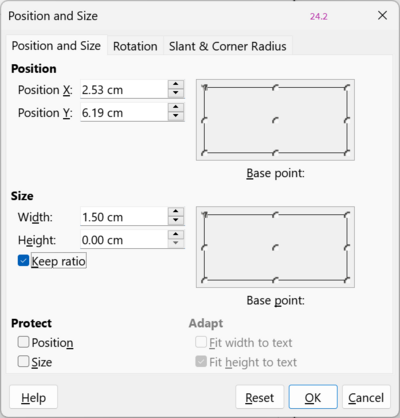
For example, a circle, like other shapes, is positioned by default using the top left corner of the rectangle surrounding the shape.
But in "Position and Size…" (see above) you can set the base point in the center and then enter its position as desired.
Further Informations
Documentation / Manuals
Here you will find the Documentation / Manuals:
Any questions?
For questions on this topic go to:
Get Involved
Join us today and help us to make it even better!
Donate
LibreOffice is Free Software and is made available free of charge.
Your donation, which is purely optional, supports our worldwide community.
If you like the software, please consider a Donation.